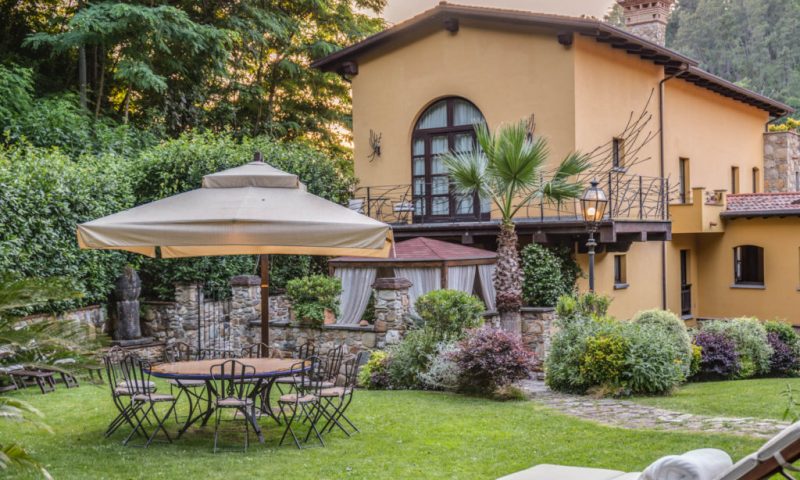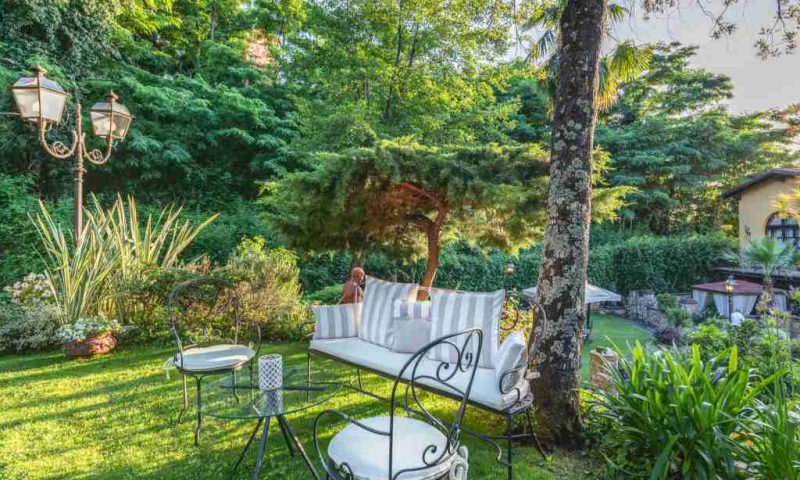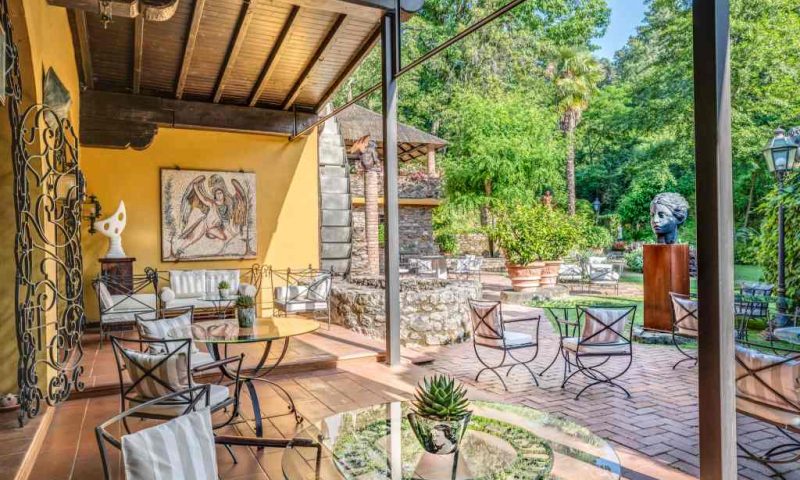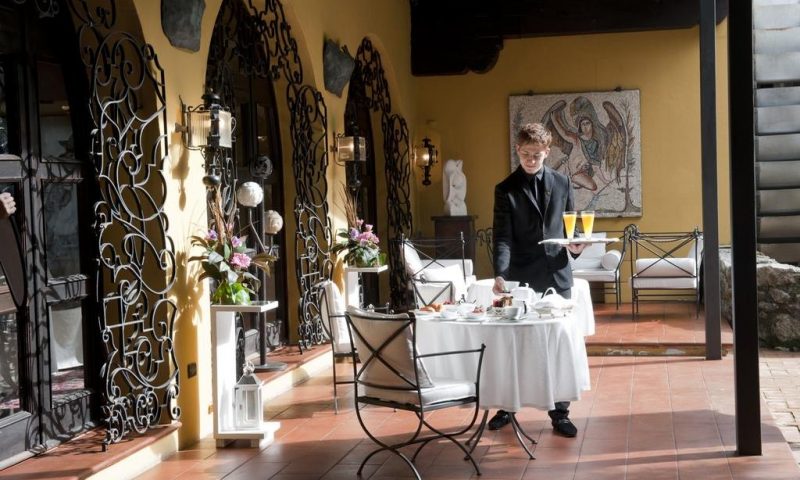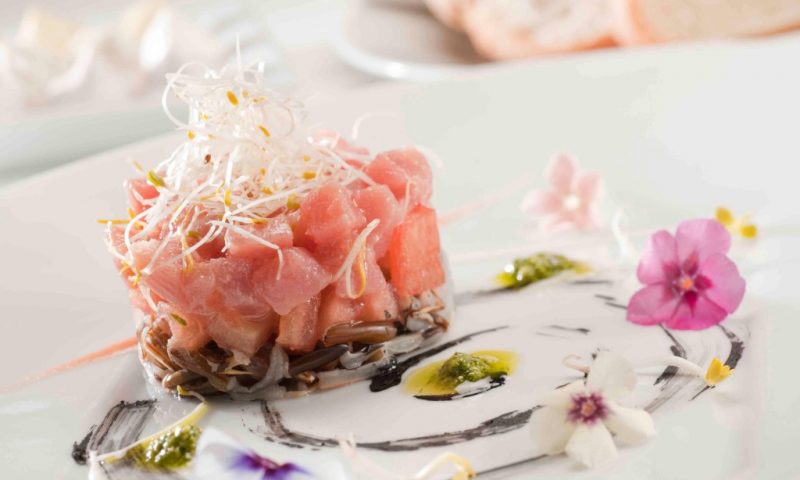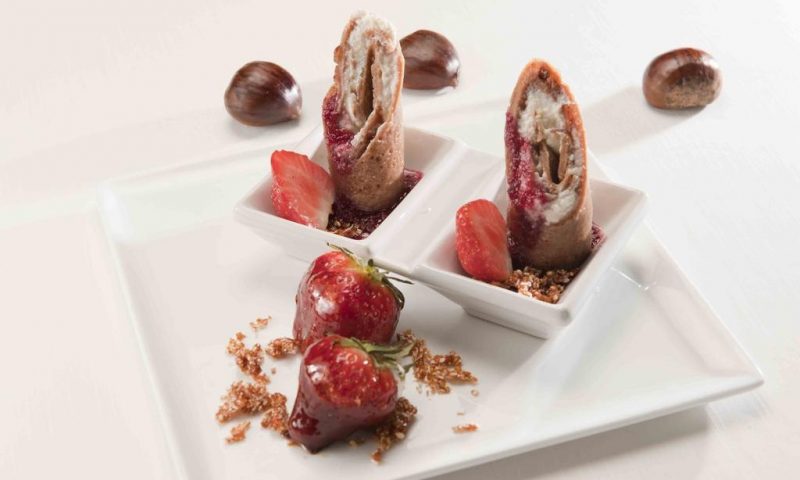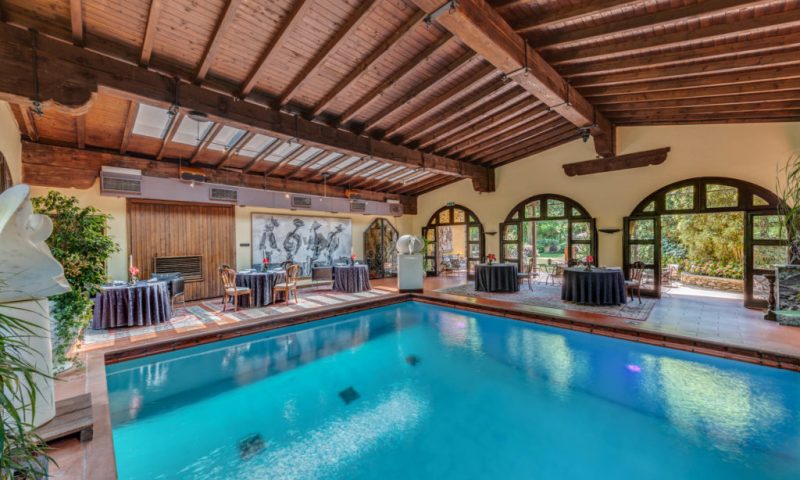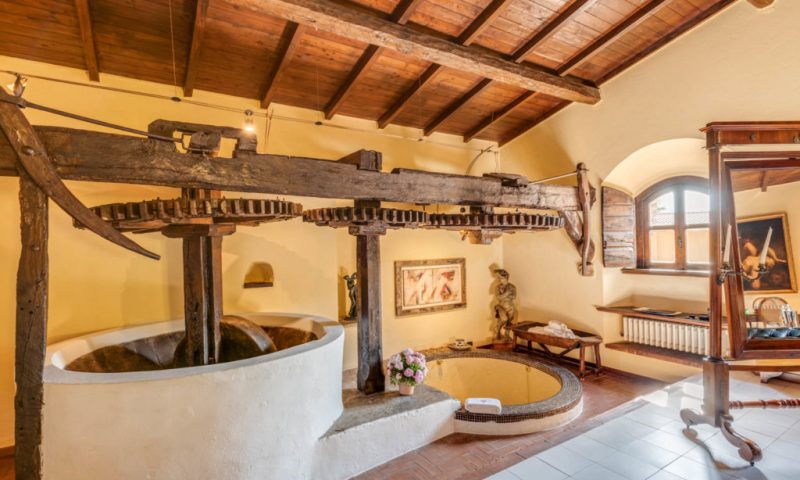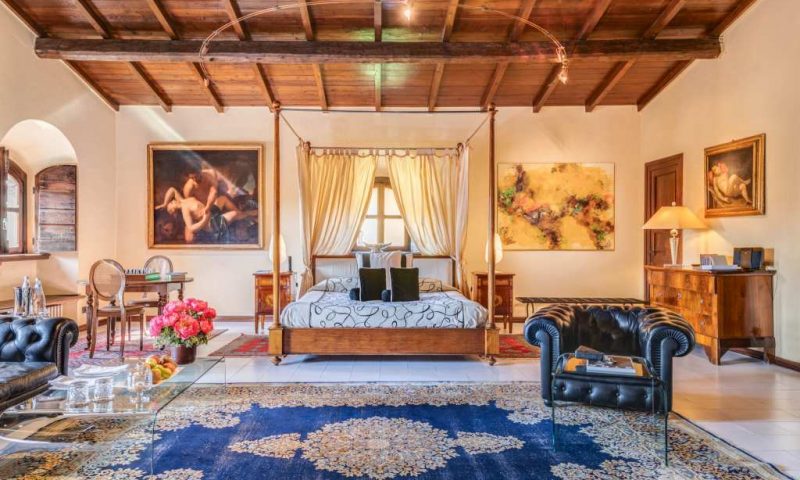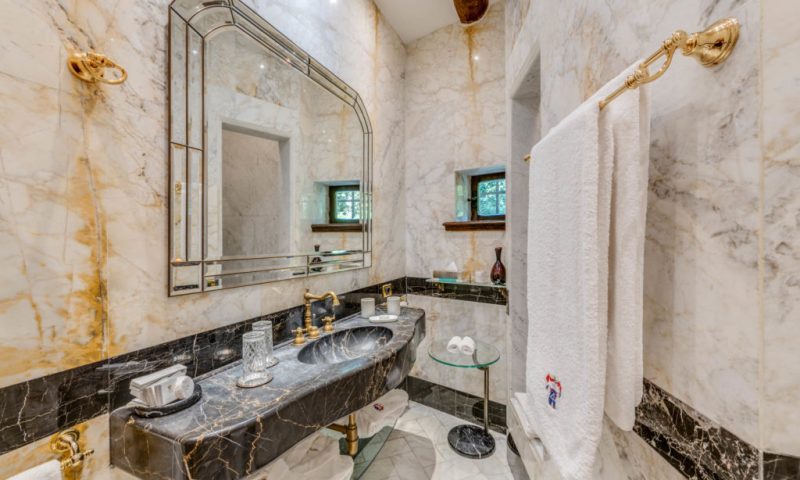Il Bottaccio is an exclusive boutique art hotel in Tuscany, dreamed of being a unique place where nature meets the most sophisticated luxury. An intimate retreat for lovers of privacy, at the foot of the green hills of Forte dei Marmi and since 1988 a maison Relais & Chateaux.
Il Bottaccio has been transformed into a boutique 5 star hotel in Tuscany as a result of the careful restoration of the old XVIIIth century water mill. An oasis of wellbeing, one step away from the beaches and shops of Forte dei Marmi.
A unique luxury hotel, where you can celebrate a special, unique occasion: a wedding or a honeymoon, to relax with wellness treatments in our Otzium Wellness Spa, or enjoy a romantic holiday in the heart of Tuscany.
Water and marble. The spirit of Il Bottaccio is nourished by these two elements.The Tyrrhenian Sea, the mountain streams and torrent that turned the great wheel and gears of the olive press, and the “white gold” – statuary marble from the caves above Carrara, where Michelangelo chose the stone for his David and Pietà.
Today, water has replaced the oil that once filled the great cleansing vat (the pool is now the centerpiece of the restaurant), and the marble now appears in the form of an extravagant collection of sculptures.
Avid patrons of the Arts, founders and owners of an exclusive English College, Il Bottaccio was for many years their family home. A drawing room for friends. And now, an intimate retreat for lovers of privacy. A haven for the gourmet traveller.
Just minutes away from the glitz and glamour of Forte dei Marmi, Il Bottaccio is the most strategic point in the region to satisfy both a desire for tranquillity and a hunger for culture.
Lucca and Pisa are nearby, as are the Cinque Terre, Lunigiana and Torre del Lago with its Puccini Festival. Only a short distance away lies Pietrasanta, a city of art with ancient marble and contemporary sculptors, and more recently home to artists like Moore and Botero.
Amidst the cool foliage of Il Bottaccio’s garden, crossed by a gurgling stream, the luxury of tranquillity reaches its highest expression. On the hearth of its fires Chef Nino Mosca works his magic, creating the signature for an experience that will remain with you forever.
Here your ‘restoration’ is complete. Nino’s modern, inspired cuisine blends fruits of the Tyrrhenian Sea with flora and fauna from the Apuanian woodland.
The freshest produce from nearby Camaiore, the sausages from Ado, the pressed ‘lardo of Colonnata’ and rich goats’ cheeses…and the most important ingredient – your wildest dreams.
Careful attention to each diner gives flight to a unique process of discovery which will take you by surprise as you find even your most hidden culinary desires are anticipated.
If you don’t guess it, you can find the underlying philosophy of Il Bottaccio captured on the handmade wrought iron and glass tables in the garden:’Visibilia ex Invisibilibus’ the visible comes from the invisible. The world is as you dream it!
ROOMS & SUITES
Located in an environment and in a structure unique in the world, Relais & Chateaux Il Bottaccio has eight exclusive rooms and suites. Classic and refined furnishings blend harmoniously with design pieces and works of contemporary art.
The precious fabrics, the original paintings, the designer pieces and the sculpture collection create a welcoming and harmonious environment. A perfect location for a holiday immersed in the greenery and discreet luxury of Tuscany, a few steps from the golden beaches of the Versilia coast.
In all our rooms and suites you will find the exclusive line of Tuscan Soul – Bianco di Carrara bathroom amenities by Salvatore Ferragamo.
PRESIDENTIAL SUITE
The Presidential Suite is also called the ‘little church’ suite for its high cathedral ceiling and for the typical shape of a simple, little country church. This suite features a custom-made spiral case which gently invites guests to the loft living space above.
The modern and antique furniture together is enhanced by the “fossil marble peel” of the “Erfoud” quarries that dominates the green marble of the in room bathtub. The white Frau bed is nestled perfectly in a cove facing the two–storey garden window.
THE RESTAURANT
Il Bottaccio Restaurant and Lounge Bar is the precursor of a formula which originates from the marriage of intuition with fine cuisine. A haven for the gourmet traveller who doesn’t like hotels, the table at Il Bottaccio is an altar around which the four elements – air, earth, water and fire – celebrate the rites of the senses.
For the fortunate guests of this antique olive oil mill, it is impossible to distinguish where the restaurant ends and the art gallery begins.
Its refined collection of sculptures, paintings, antique and modern furnishings, and careful blending of styles create the canvas for an unforgettable dining experience. Here the food is made of a finer substance, where perceptions, sensations and emotions combine to nourish both body and soul.
Here cuisine is exalted through the subtle infusion of beauty, rhythm, and poetry adding the unique quality that demarcates the establishment’s passage from Profession to Art.
CHEF NINO MOSCA
The D’Anna family entrusted Il Bottaccio to the Chef-Director Nino Mosca over 35 years ago, and has watched it grow with passion to become not only an institution, but a mecca for the devotees of fine Italian cuisine.
In Nino there is the precious gift of equilibrium, acquired from years of dedication, experience and introspection, which permits him to blend a luminous creativity with the most profound roots of Italian tradition.
The cuisine of Il Bottaccio is made not only of a physical, material food, but also of a much more subtle one – an invisible plankton made of perceptions, sensations, and emotions generated by the atmosphere and environment itself.
This beauty, rhythm and poetry give the cuisine of Il Bottaccio that unique quality that transports it from being a simple trade to an art gourmet encounter to an unforgettable personal experience.
THE BREAKFAST
It is served ‘A la Carte’, allowing you to choose whether to enjoy it in your room, at the tables on the veranda if the weather permits or in the winter season near a romantic fireplace. Abundance and variety are the characteristic features of Il Bottaccio breakfast, combined with research into the quality of the freshest products.
Homemade bread and fragrant croissants accompany sweets and jams strictly made with seasonal fruit. The selections of local cured meats and cheeses are accompanied by a wide choice of egg-based recipes freshly prepared.
In the selection of drinks you will find different varieties of coffee, tea and herbal teas plus centrifuged and fresh juices that complete what can be defined as the sweetest of awakenings.
THE COOKING SCHOOL
For the fondest Taste Explorers, personalized individual classes ensures you have a hands-on learning experience with personal instructions. Courses are available each morning under previous reservation all year round.
At Il Bottaccio you will have the chance to participate in a working kitchen, giving you the behind-the-scenes experience of a top Italian restaurant. Each day, the school focuses on different aspects of cooking and Italian cuisine.
The menus and the lessons are designed in conjunction with the specialties of the season, using only the freshest ingredients and top quality.
THE LOUNGE BAR
With an impressive list of champagne and extraordinary cocktails, the inviting atmosphere of Il Bottaccio Lounge Bar is perfect for an evening drink accompanied by gourmet canapé, an apéritif in a relaxing and luxurious environment only a 5 star hotel like Il Bottaccio can offer.
Our Bar Manager has created an exciting selection of original cocktails or any classic drink in typical Il Bottaccio style. * from 7.00 pm to 11.00 pm, Friday, Saturday and Sunday, from June 25th until September 12th
SALA DIANA
This two-storey space is dominated by the presence of an antique painting depicting the bathing goddess Diana surprised by hidden onlookers. The huge richly coloured canvas is attributed to a pupil of Titian, Nicolo Bambini.
SALA DELLA PISCINA
Our unique “Sala della Piscina” – heart of the Bottaccio complex, houses the main body of the restaurant in a perfect symphony of elements played between the pool lying at the room’s center, the giant wooden trusses flying high above, and the oversized glass and wooden portals marching down both sides.
OTZIUM WELLNESS SPA
The Otzium Wellness Spa offers a wide choice of treatments, carefully created, so you can relax and breathe the utmost atmosphere of one of the most beautiful spa hotels in Tuscany.
The art of living is making yourself your own masterpiece. With its eight exclusive suites, the luxury boutique hotel with spa in Tuscany has created an oasis of being around this philosophy.
A private spa in a unique setting. The temperature of the rooms and the music create a peaceful atmosphere, guaranteeing, in addition to impeccable relaxation and therapy, privacy and exclusive comfort.
The Art of living and making of oneself a masterpiece Il Bottaccio has created an oasis of being around this philosophy – a luxury boutique spa – for believers that the body and spirit are reflections of one another, that a healthy body creates a healthy world, and that the two should be nurtured and cared for together.
Its very name, ‘Otzium,’ springs from the Latin word for ‘not doing’-‘ozio’. Here, stripped of every role, and abandoning every identification with the clamour of daily life, time is suspended. The body begins to dream again, in contact with the truest and most sincere part of itself.
This is the real wealth, the only luxury. The mastery of the masseuse, the aromatherapy and chromo-therapy, are elements of a personally prescribed wellness path that culminates in the rare and unique Hammam – the original Turkish Bath. Jewel of hundreds of years of careful study and knowledge of the secrets of the body.
Crossing the threshold of the world of Otzium Wellness Spa, you are enriched with its subtle food of perceptions, sensations and emotions, you become enabled to close every internal distance, to take life back into your hands, and to become again responsible for being healthy, happy and free – your natural birth rights.
CREATIVE LEISURE
This is the real wealth, the only luxury. The mastery of the masseuse, the aromatherapy and chromo-therapy, are elements of a personally prescribed wellness path that culminates in the rare and unique Hammam – the original Turkish Bath – jewel of hundreds of years of careful study and knowledge of the secrets of the body.
Crossing the threshold of the world of Otzium, you are enriched with its subtle food of perceptions, sensations and emotions, and are enabled to close every internal distance, to take life back into your hands, and to become again responsible for being healthy, happy and free – your natural birth rights.
WEDDINGS & EVENTS IN TUSCANY
Charm and Story …the Ideal Setting for unforgettable Weddings and Events. Spacious rooms permitting various modular solutions, optimum acoustics, modern technological equipment and above all the high architectonic value of Il Bottaccio, an exclusive place for events at just 3km from Forte dei Marmi.
The rooms, “Diana” and “Piscina”, different in their characteristics and atmosphere, allow creating special ambiences, to satisfy the desires and highest demands those wanting to live a stylish and unforgettable experience.
Elegant and sophisticated rooms with a unique atmosphere, the wonderful garden, professional and friendly personnel, quality of service customised to guarantee satisfaction for each of our guests: these are the elements that makes Il Bottaccio an ideal setting for the most beautiful weddings and events.
We are at pleased to offer advice and assistance in organising your wedding or a special event. You will have at your available the rooms, the suites, the spa, the restaurant and the garden. We will be happy to fulfill your requests.
CONFERENCES & MEETINGS
Il Bottaccio: the perfect destination for conferences, seminars, corporate events. Il Bottaccio can host up to 110 persons indoors. An ideal design to guarantee the highest level of efficiency and project flexibility and all the advantages of an incomparable location where an event or meeting becomes a moment of pleasure and of infinite opportunities.
EXPERIENCES
The art of living requires a subtle balance between leisure and wellness as natural expressions of Being.
The search for harmony and the joy of living with curiosity drives us to discover ever new destinations where the unique features, the genius loci, create for us unforgettable memories. Discover our exclusive experiences and treat yourself to an unforgettable holiday in Tuscany.
FORTE DEI MARMI
In Italian Forte dei Marmi means “Fort of the marbles”. The town takes its name from the fortress that rises in the middle of the main square, built under Grand Duke Peter Leopold, who was to become Leopold II, Holy Roman Emperor, in 1788.
The fortress was built to defend the coast from outer attacks, but in the 19th and the beginning of the 20th century it became the place where the marble quarried from the Alpi Apuane (they are the same mountains of the famous marble of Carrara) was stocked before being sent to the pier for shipping.
Sea and culture are the two characteristics of Forte dei Marmi. in addition to the beauty of its beaches and its center, Forte dei Marmi is famous also for its festivals (of Sant’Ermete and San Francesco) and for its markets (antique fair, weekly market in Marconi square, and at Victoria Apuana).
The sea is not the only attraction in Forte dei Marmi, as also its surand ancient traditions. Here you can undertake interesting excursions to discover the Apuan Alps and the entire Province of Lucca.
The center of town is rich in shops and high fashion boutiques with designer’s clothes and it is a must for visitors to go out shopping also late in the evening during summer time.
CARRARA MARBLE QUARRIES
When driving along the west coast of Tuscany just north of Pisa, you will see jagged Alps rising steeply from the narrow strip of land, glistening majestically. These are the Alpi Apuane, or Apuan Alps, mountains that gleam as though cloaked with snow all year round.
But the pristine white is not snow, it is the marble of the bare quarried faces of the mountains – the snow the gods made eternal.
The effect is so surreal it would not be out of place in a mural in an Indian restaurant, but this breath taking view belies a multi-million euro a year industry and the source of some of the most famous sculptures in the world – including Michelangelo’s Pietà and David.
The marble quarries of Carrara are situated in the valleys of Torano, Miseglia, Bedisano and Colonnata, where both white and coloured marbles are found: the amount of marble is staggering.
From raw cut blocks waiting for export, rows of flawless reproductions of Michelangelo’s David, to the marble-clad center of Carrara, it is clear that marble is the main protagonist of this area.
Driving further up into the mountains around hairpin turns through the lush green forest does nothing to prepare you for the number and scale of the marble quarries that were first opened up by the Romans more than 2000 years ago.
ANCIENT ROOTS
Written records dated to 177 BC describe Romans who were sent to the colony of Luni with a full complement of slaves to extract the marble and ship it back to Rome for use in palaces and monuments – all engraved with A.U.PH. (ad usum phori – for use in the Forums) to avoid taxes.
It was the white marble of Carrara that converted Rome from a city of brick huts to one of marble palaces. The Renaissance was boom time for Carrara. Marble was de rigueur in Florence, Venice and Rome, and there was plenty of money being invested in art.
Michelangelo travelled to the Alpi Apuane to choose his marble, and eventually to open up rival quarries to those of Carrara for his patrons the Medici.
Michelangelo worked in the Serra gorge, favouring the whitest, most finely veined marble and he dreamed of carving the figure of a giant out of 5000 ft Monte Sagro. By the 14th century, mining methods had not changed much from the times of the Romans.
Stonecutters climbed for miles up the vertiginous peaks in squads to drill holes in the rock into which they drove wooden stakes. They then wet the wood, which expanded and split off huge blocks of marble.
FAT OF THE LAND
As you might imagine from the name, lardo is pure pork fat. However, it is not just any old bacon – it is pork back fat, cut into strips and laid into chests of marble called conche with sea salt, garlic, black pepper, and a mix of other spices, including sage, rosemary, cinnamon, cloves and coriander.
The combination of spices varies between the producers, or larderie, who guard their recipes jealously. The lard is then aged in the conche for six to ten months.
PIETRASANTA, THE CITY OF ART
Pietrasanta, is a historic medieval and artistic town in northern Tuscany sometimes called the City of the Artists or Small Athens for its marble studios and monuments.
The town has Roman origins but the modern town is named for its founder Guiscardo Pietrasanta who built it in the mid-thirteenth century as part of the republic of Lucca. Unlike many popular Tuscan towns, Pietrasanta is not a hill town and its historic center is a pleasant place for strolling.
It’s an important center for working marble and was used as a marble source by Michelangelo. Several international artists live or work here and there are art galleries and exhibits. The Bozzetti Museum is a very important museum of sculpture and sketches.
Thursday is market day in Pietrasanta. There’s an antique market the first Sunday of the month and a crafts the second Sunday of the month. There are several shops that sell handicrafts, marble items, and artworks. San Biagio day is celebrated with a fair in early February.
- Piazza del Duomo is the large main square. Here you’ll find cafes, people, art exhibits, the town’s principal buildings, and of course the Duomo.
- The Duomo, Church of S.Martino, dominates the square. It was built in the fourteenth century but has been remodeled several times. The exterior is covered with marble and inside are murals by Aldemollo and other important works of art.
- Palazzo Pretorio, the town offices and Town Theatre, was acquired by the town in the fourteenth century and has been remodelled several times. From the fourteenth to nineteenth centuries, it was center of the Vicar and the Captain of Justice and coats of arms can be seen on the marble facade.
- The Bruno Antonuci Archaeology Museum is inside the 16th century Palazzo Moroni on Piazza del Duomo. Exhibits range from prehistoric and Etruscan to medieval and Renaissance objects.
- Tower of the Hours, Torre delle Ore, started construction in 1530 but its current look dates from 1860.
- Bozzetti Sculpture Museum shows sketches, models and drawings of sculptures carried out by hundreds of Italian and foreign artists who worked at Pietrasanta, such as Botero, Cascella, Theimer, Folon, Mitoraj, Yasuda, Pomodoro, Tommasi and Gina Lollobrigida (the Hollywood star). It’s in the St. Agostino complex.
- St. Agostino’s Church and Convent is a complex originating in the fourteenth century. The church is Romanesque and has a marble facade. Inside are many important paintings and frescoes and a restored wooden choir in the apse. It’s currently the seat of art exhibits. The courtyard of the cloister is surrounded by marble columns and part of the frescoes that once adorned the walls are still visible. Today it houses the Center Cultural Luigi Russo, library, Museum of Sketches, and Bozzetti Sculpture Museum.
- Rocchetta Arrighina, Porta a Pisa is the only survivor of the three ancient town gates. Originally built in the fourteenth century, it had a 17th century fresco of the Annunciazione which is now near the town hall.
- Church of San Antonio Abate, documented since the fourteenth century, has ancient wooden statues and contemporary frescoes.
- Rocca di Sala and Guinigi Palace sits on a hill behind the city center. The fortress was restructured in the fourteenth century and the small residential palace was built by Paul Giunigi in the fifteenth century.
THE FIVE LANDS
The charm of the hill overhanging the sea a wonderful choreography that seems to have been designed by a romantic painter who traced an extremely intense painting, a treasure, vaunt of the Province of La Spezia, destination for tourists from all over the world.
Houses and paths suspended between the earth and the sky make it a natural beauty unique also because kept intact and faithful to the nautical tradition. Your journey in the beautiful places characterizing The Five Lands starts from Brognato motorway‘s exit.
Then, trespassing Borgetto Vara, Pignone, we‘ll reach Monterosso, the first of the five little villages. The arrival is made much more suggestive by the peculiar nature of this place got out of the rocks.
You will be welcomed by the Statue of the Giant (a Neptune rested to the cliff to guard the sea). Then Vernazza, Corniglia, Manarola and Riomaggiore.
RIOMAGGIORE & MONTEROSSO
The Cinque Terre own a large part of their tourist success to the paths that wind along the coast or reach sanctuaries, which overlook each village. The path that connects Riomaggiore to Monterosso is the most famous and spectacular one and is called the “blue path“(“il sentiero azzurro“).
In order to travel the whole path, one needs to walk for about five hours and to go through a difference in height of 500 meters.
The path was traced over the centuries by those who used it to travel from place to place, therefore in some points, it is a real bridle path which unwinds itself by the seaside and connecting the five villages amongst themselves.
RIOMAGGIORE & MANAROLA
Starting from the Riomaggiore train station, going up on left, one can find the access stairs, with ramps for disabled people that lead to the Path of Love (Via dell‘Amore), the typical path connecting the village to Manarola.
The path was dug in the hard rocks and runs close to the sea on which it leans out. Along the way, you can see various types of vegetation such as agaves, pitosfori, Indian fig, vanilla plant, rue and many others.
MANAROLA & CORNIGLIA
Once in Manarola, more precisely in the Marina, the path offers two possible ways to continue, depending on the time available.
If you aren‘t in a hurry, you can do the “Birolli” walk, which leads to Palaedro. It is a 250 meters section witch turns around the Punta Bonfiglio and which has recently been equipped with a playground and a petanque field.
Otherwise, you can clamber up the slope, which leads to the cemetery of Manarola where the path is characterised by a long gravelled and pebbled beach, which takes the place of the rocky cliffs.
CORNIGLIA & VERNAZZA
The path continues, skirting the numerous vineyards of Corniglia. The atmosphere is shady and the land is covered by a meadow where there are many plants such as anemones, orchids and lords-andladies.
One then goes down small stairs on the left and walks through olive trees, vineyards and Mediterranean maquis until overlooking the residential area of Vernazza.
VERNAZZA & MONTEROSSO
It is the toughest section of the path. You need to exit the village and start going up, towards the cemetery, which skirts the path. The bridle path is in steep gradient: one quickly reaches the altitude of 150 meters; from this moment on, one will continue, slightly going up and down, until the precipitous descent towards Monterosso.
Going forward, one goes through the Mediterranean maquis, which covers the now abandoned pieces of land. The vegetation is quite diverse; you can find holm oaks, arbutus, white Heather Spanish broom, and juniper.
FIVE LANDS SAILING TOUR
The Rio 950 Cruiser has all its spaces optimized to make your day on the boat comfortable with a large sundeck at the bow, a comfortable aft cockpit with a table that can be transformed into a surprising sundeck!
The 2 powerful and performing Mercruiser sterndrive engines of 250 hp allow you to reach the most beautiful places in the Gulf of Poets and Cinque Terre quickly.
- Boarding hours 10 am / Unboarding hours 5 pm
- Departure at 10:00 from the Harbour of Bocca di Magra (a driver will bring you from the hotel to the harbour and back), from which you can immediately admire the splendid landscape of the Montemarcello Natural Park with its beautiful coves and the ancient seaside village of Tellaro, listed among the most beautiful villages of Italy!
Before reaching the Cinque Terre, a must is the stage in the pearl of the Gulf: the fascinating PORTOVENERE!
This ancient fishing village will leave you breathless: admiring the “Palazzata a Mare” from the sea, that is a group of buildings close together which, high up, face the horizon is undoubtedly a very suggestive sight; the different widths of the facades, as well as the uneven heights and the pastel colors that alternate between them, create an unusual spectacle for any other region of northern Italy.
The Doria Castle, the ancient church of San Pietro and the Grotta di Byron, set in a fascinating inlet. The tour will then continue to the Cinque Terre National Park, a territory where sea and land come together to form a unique and suggestive area, which since 1997 have been included by UNESCO in the list of World Heritage Sites!
Possibility of unboarding for about 1 hour in Vernazza by taxi boat. During the day several stops are scheduled for a refreshing swim in the wonderful coves for funny snorkeling. A good glass of wine will not be missing on board to accompany a light lunch based on local products.
The Cinque Terre represent one of the most beautiful natural Mediterranean areas of Liguria in a coastal stretch of the east about 10 km long characterized by the presence of the five ancient seaside villages overlooking the sea: Monterosso, Vernazza, Corniglia, Manarola and Riomaggiore.
VISIT & WINE TASTING ORNELLAIA
This private wine tasting tour, can be reserved for 10.30am or for 3.00pm; averaging 3 hours in length, it takes in our vineyards and winemaking facility, and concludes with a guided wine tasting. Price: Euro 100,00 per person. Upon request and at no extra cost, you can taste our Extravirgin olive Oil as well and Eligo dell’Ornellaia, our Grappa Riserva.
The Ornellaia Estate was created in 1981 and is located near the picturesque village of Bolgheri, on the unspoilt Tuscan coast. The uniqueness of the area was epitomized by the famous poet Giosuè Carducci who gave eternal fame to the monumental Cypress Avenue leading up to Bolgheri.
The coastal plain is a natural refuge to numerous migratory birds and other protected species. In the midst of all this natural beauty lie the vineyards of Ornellaia.
WINE TASTING TOUR – ANTINORI CHIANTI CLASSICO
Entering into the wine cellars of Cantina Antinori in Chianti Classico means to become a participant in the adventure which winds you through six centuries of history of the Antinori family and their passion in producing wine.
The visitor is accompanied by the guides along a route which is, at the same time, historical and emotional, technical and architectural, culminating in a tasting of our wines.
To visit the wine cellars, it is possible to choose between two routes which, from the vineyards to the bottle, explains the art of producing wine at Antinori: the Barricaia (Barrique) cellar tour and the Bottaia (traditional Tuscan wine barrel) cellar tour.
- Barricaia Visit: The visit is conceived as a trip through the wine world and history of the Antinori family, all briefly illustrated in the Cinzia Th. Torrini’s short movie dedicated to the family, “The Antinori: vintners since 1385”. The tour moves from the outside to the inside of the winery, permitting to see the great spiral staircase, the vineyard covering the winery roof and the vinification and aging areas. At the end of the tour a tasting of some typical labels from our estates: Vermentino (Bolgheri DOC), Cont’Ugo (Bolgheri DOC) e Villa Antinori (Chianti Classico DOCG Riserva). The wines could change depending on the season and the availabilities. The visit lasts approximately an hour and a half. Tour in group with other guests: 35.00 € per person. Junior until 17 years old 8.50 € – Children under 6 years old free. The tours are in Italian and English, tours with translator only under previous agreement.
- Bottaia Visit: The short movie on the Antinori family, Cinzia Th. Torrini’s “The Antinori: vintners since 1385” introduces to the museum area where to admire some of the works of art from the family’s private collection, both of ancient and contemporary artists and illustrates the history of the Antinori family and its fundamental role in the florentine life of the past centuries. The tour moves from the outside to the inside of the winery focusing on the productive processes and the innovative architecture. At the end of the visit, the tasting of some wines: Villa Antinori Chianti Classico DOCG Riserva, Marchese Antinori Chianti Classico DOCG Riserva, Badia a Passignano Chianti Classico DOCG Gran Selezione, “A” (Toscana Rosato IGT). (Wines may vary according to the season and the availability). The tasting will take place either in the impressive suspended room or in the more intimate Bottaia room. According to the season, it will be possible to taste the “Olio novo”, the biological Pèppoli Extravirgin olive oil. The visit will last approximately two hours and half. Prices: Tour with other guests: 60€ each. Junior until 17 years old 12€ – Children until 6 years old free. The tours are in Italian and English, tours with translator only under previous agreement. The Restaurant “Rinuccio 1180” is situated in an ample open space, with windows to the panoramic terrace, which offers traditional Tuscan dishes revisited in a contemporary style.
- Bottaia CRU Visit: An emotional path through the architecture and the tuscan flavors which will reveal, at the same time, both the full majesty of the cellar and the intensity of our most representative wines. Cervaro della sala Umbria IGT, Badia a Passignano Chianti Classico DOCG Gran Selezione, Pian delle Vigne Brunello di Montalcino DOCG, Tignanello Toscana IGT will be tasted in the exclusive and intimate Bottaia room or in the impressive suspended room, a space with a view over the barrel room. The visit will finish at “Rinuccio 1180” restaurant overlooking the hills of Chianti Classico, where Conte della Vipera Umbria IGT and Guado al Tasso Bolgheri DOC Superiore and the dessert wine Muffato della Sala Umbria IGT will pair dishes from the tuscan tradition re-elaborated in a contemporary vein. The tour lasts about two hours and half (lunch not included). The tour is in group with other guests. Prices: €160 per person (lunch included) – The tour is not suitable for kids and juniors. The tours are in italian and in english, tours with translator only under previous agreement.
SAN GIMIGNANO THE MANHATTAN OF THE MIDDLE AGE
San Gimignano rises on a hill (334m heigh) dominating the Elsa Valley with its towers. Once the seat of a small Etruscan village of the Hellenestic period (200-300 BC) it began its life as a town in the 10th century taking its name from the barbarian hordes.
The town increased in wealth and developed greatly during the middle Ages thank to the “Via Francigena” the trading and pilgrim‘s route that crossed it. Such prosperity leads to the flourishing of works of art to adorn the churches and monasteries.
In 1199 it became a free municipality and fought against the Bishops of Volterra and the surroundings municipalities. Due to internal power struggle it eventually divided into two factions one headed by the Ardinghelli family (Guelphs) and the other by the Salvucci family (Ghibellines).
On the 8th May 1300 Dante Alighieri came to San Gimignano as the Ambassador of the Guelph Death in Tuscany. In 1348 San Gimignano‘s population was drastically reduced by the Black Death Plague throwing the city into a serious crisis, which eventually led to its submission to Florence in 1353.
In the following centuries San Gimignano overcame its decline and isolation when its beauty and cultural importance together with its agricultural heritage were rediscovered.
The construction of the towers dates back to the 11th and 13th centuries. The architecture of the city was influenced by Pisa, Siena and Florence. There are 14th century paintings of the Sienese School to be seen and 15th century paintings of the Florentine School.
The Duomo or Collegiate Church, was consecrated in 1148 and is adorned with valuable Sienese School frescoes: “The Old and the New Testament”(Bartolo di Fredi and the “Bottega dei Marmi” or Barna da Siena); “The Last Judgement”(Taddeo di Bartolo) works of art by the Florentine school: ”Stories of St. Fina”(Ghirlandaio), “St. Sebastiano”(Benozzo Gozzoli), wooden wooden statues (Jacopo della Quercia) and the Sculptures (Giuliano and Benedetto Gozzoli).
Frescoes, statues and sculptures make the Collegiate Church of San Gimignano a very prestigious museum. The People‘s Palace: The People‘s Palace courtyard ad Dante‘s Hall with “The Maestà” by Lippo Memmi.
The Civic Museum and the Picture Gallery with works by Filippino Lippi, Pinturicchio, Benozzo Gozzoli, Domenico di Michelino, Pier Francesco Fiorentino, Sebastiano Mainardi, Lorenzo di Niccolò di Martino, Coppo di Marcovaldo etc. Entering the Civic Museum the 54 metre high “Great Tower” of Podesta‘ stower built in 1311 can be visited.
The Museum of Sacred Art: Canvases, tablets, works in stone, which come from former churches and monasteries, sacred silverware, vestments and psalm books. The “Raffaele De Grada” Gallery of Modern and Contemporary Art is an important exhibition space for the city.
While in other cities, such as Florence, most or all of their towers have been brought down due to wars, catastrophes, or urban renewal, San Gimignano has managed to conserve fourteen towers of varying heights, for which it is known internationally.
PISA
Although it is worldwide famous due to its Leaning Tower, the city of Pisa also has many other great attractions and amazing characteristics to offer. Pisa is one of the most important historic Italian areas and one of the most visited years around as well.
This city allows tourists to meet buildings that conjugate many different époques and artistic currents, such as, for example Romanesque and Gothic among many others.
Pisa is located towards the western area of Tuscany, and its origins date from as long as 3.000 years ago. During that time, settlements started being built up at seaside and gave origin to what today is one of the most famous cities in the world.
This way, the historical richness of Pisa is amazing due to its great amount of years and this can be observed in the buildings, which have remained through the pass of time and which shows the different époques through which the city has passed.
Another one of Pisa‘s main characteristics is its university, established in the first years of 1340 and worldwide known due to its excellence.
This way Pisa is a city, which gives main importance to knowledge, science and arts, being up to date with modern life as well as maintaining some of the characteristics, which gave it shape through time. The Learning Tower is located in the northwest area of Pisa, sharing one same area with other important buildings.
At this area, known as Campo dei Miracoli, next to the famous Leaning Tower, there are other three great and unique buildings: the Camposanto or Holy Field; the amazing Duomo or Cathedral of Pisaof 1000 years; and the Baptistery or Battistero of circular shape.
There are several other buildings and interesting areas for visitors to meet in Pisa besides the Campo dei Miracoli. Towards the south side of the city, tourists can visit two interesting museums: the Museo delle Sinopie and the Museo dell‘Opera.
LUCCA
“ Lucca…a compact and admirable little city, the very model of a small pays de Cocagne, overflowing with everything that makes for ease for plenty, for beauty, for interest and good example.” (Henry James, “Italian Hours”) This quaint and evocative city retains the charm of a small and ancient Italian City State.
Over the centuries it has managed to hold on its independence and freedom by adopting an cautious policy. Having miraculously escaped the devastation of the war, today it boats one of the most extraordinary Tuscan and heritage.
The imposing tree-lined Renaissance walls, which totally enclose it, the maze of medieval streets, flange by towers and smart boutiques, the enchanting Romanesque churches and bright inviting squares captivate the visitor who stands in awe of such unexpected beauty.
- Piazza Anfiteatro, built on the ruins of the ancient Roman arena, is still today one of the most picturesque landmarks of the town
- Guinigi Tower, one of its kind has a very suggestive tree lined hanging garden right on the top
- Basilic di San Frediano, Is one of the most ancient churches in Lucca famous for the splendid gilded mosaic on the façade
- The 16th century Walls, built for defence reasons, are today a public garden for the enjoyment of all. You can take a leisurely stroll, ride your bike or even take a ride on a carriage to better appreciate their beauty.
PALACES & MUSEUMS
It is possible to change or extend the city tour including a visit to some of the most beautiful “Palazzi” belonging to the merchants of Lucca
- Palazzo Mansi, one of the most important noble palaces in Lucca. Elaborately furnished, is the symbol of wealth archived by the mercantile families of Lucca, Today it is The historical center, now a pedestrian precinct, plunges the visitor back in time and provides the perfect setting to savour the old warm charm, where time and space take on a new dimension, no longer found in today‘s modern cities.
- Piazza S. Michele in Foro, to admire the church bearing the same name
- Piazza Napoleone, from this square we can admire Palazzo Ducale and Teatro del Giglio (the theatre)
- Cathedral San Martino, important destination for medieval pilgrims who came here to worship “Il Volto Santo” (The holy Countenance of Christ), is still today an important symbol of the city. Inside the sacristy is the renowned sarcophagus of Ilaria del Carreto by Jacopo della Quercia. A definite must (admission fee)
- Characteristic medieval streets, worthy of mention is “via degli antiquari” where we can see the fine antique shops and the teeming and smart Via Fillungo. the National Museum which houses paintings from the 16th to the 20th centuries
- Villa Guinigi, an ancient Gothic villa that belonged to the Guinigi family. Today is a National Museum witch houses in two halls, paintings and sculptures from Lucca and its territory from the very origins to the 18th century
- Palazzo Pfanner, is one of the few city palaces witch boats a Baroque garden of exceptional beauty, probably designed by Filippo Juvarra. The perspective of the hedges and allegorical statues recreates the typical stage settings of the late 17th century. It is also possible to visit the palace inside
- Palazzo Ducale, this is the government palace of the Republic of Lucca designed by Bartolomeo Ammannati. In the 16th century, the interior was completely renovated in the Neo-Classical style and later became the residence of the Princess Elisa Baciocchi Bonaparte. It is today the “Prefettura” and the local provincial administration.
MONTECARLO
Montecarlo’s urban set-up is organized around parallel and perpendicular main streets, and it is enclosed by fortified walls, towered over by the majestic Belfry of the Collegiate of Sant’Andrea, visible from the whole surrounding plain.
Of the fourteenth-century gates placed along the walls there remain Porta Fiorentina (the 15th century Florentina Gate, modified in the 16th century) to the east, the Porticciola (the 14th century Lucca Gate) to the west towards Lucca, which was widened in 1594, while Porta Nuova (or New Gate) to the south was reopened at the end of the sixteenth century.
On the main street, formerly via Grande and today Via Roma, we encounter the Collegiate Church of Sant’Andrea. In nearby via Carmignani we find the Municipal Theatre of the Rassicurati. The well-preserved town walls, attached to the fortress, can be still admiredtoday. These walls also include the three main town gates.
HORSE TREKKING
Monte Brugiana is located in the heart of the Apuan Alps, surrounded by nature, in a wonderful atmosphere, near the crest of the Apuan Alps and overlooking the nearby Versilia.
The refuge, despite being in the middle of the nature, at just 20 minutes from Il Bottaccio, is easily accessible. The farm is also involved in horse breeding. Paolo Monteleone, instructor FISE, professional guide for alpine horse trekking, takes care of all aspects.
He is the protagonist of the great European routes on horseback (as the journey from Lisbon to Massa Carrara) will be pleased to conduct even beginners within the Park of the Apuan Alps and the Tuscan-Emilian Apennines
Most of the summer activities are conducted outdoors, immersed in nature and under the typical chestnut trees. The horses of the center are perfect for walks on trails and mule tracks, or to delve into the more dense woods.
You can also attend riding lessons with instructors and guides. For trekking on foot or on mountain bike there are easy or challenging trails within the great park of the Apuan Alps.
TRAILS
- Apuan Alps Park – Tuscan-Emilian Apennines
- Casentino Forests (hermitages of Camaldoli and La Verna)
- Park Monti Sibillini – Maremma – Chianti Area
- Trails of Santiago de Compostela (medieval pilgrimage route)
- Chain of the Pyrenees
GOLF CLUB
A course nestled like a diamond between the Apuan Alps and the sea, designed by the famous Venetian architect Marco Croze. The Forte dei Marmi Golf is a luxurious oasis divided between the towns of Pietrasanta, Forte dei Marmi and Montignoso.
18 holes, par 71, for a total of 5.873 metres: these are the numbers that make up the course and that give players constant stimulus and challenging difficulties. Hole 13 is particularly venerated for its beauty and technical difficulty rated 1 and was designed by Integral Golf Design, the Spanish firm founded by José Maria Olazàbal.
